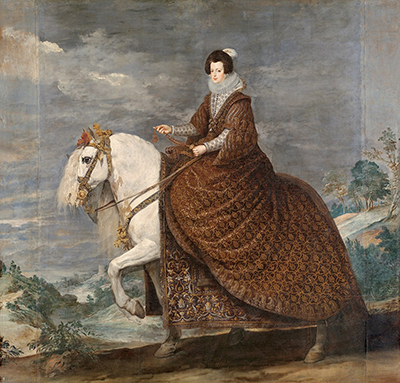Diego Velazquez's horse paintings are particularly well known, with this one capturing Elisabeth of France
As his reputation grew, artist Velazquez would receive some breathtaking commissions from some of the most regal and well connected families across Europe. To have your portrait by made someone such as this was an honour in itself, and the artist was someone who could appreciate his fame and fortunate within his own lifetime, which artists have not been able to.
A white horse is chosen here in order to match the femininity of the subject. He would also produce related sketches as well as another portrait of a white horse on its own. For some of his male equestrian portraits there would be medium to dark brown horses instead.
Elisabeth of France was Queen consort of Spain and Portugal. Crucially, she was also the first wife of King Philip IV of Spain, someone portrayed frequently by Diego Velazquez. The geographic and ruling connection between Spain, France and Portugal at this time was far more fluid than today, with Velazquez becoming connected with all of them and more besides.
Isabel, as she was also sometimes referred to, was the daughter of King Henry IV of France and his second wife Marie de' Medici. The Medici family have a unique place in the history of European art due to their wealth, connections across Europe and also their passion for encouraging and financing the arts through a considerable number of commissioned artworks.
Switching between animal and human portraits was not an easy transition. Both disciplines required considerable training and practice, with some artists specialising in one over the other. For example, George Stubbs would produce classics like Whistlejacket having spent time studying and dissecting the creature over many years. He would perform autopsies and slice open animals in his studio in order to truly understand the balance of their muscles and the functions of this beautiful creature.
Whilst his equestrian paintings are not considered as artistically impressive as those of Stubbs, or of his other portraiture, they are still considered significant within his career output and at the very least give evidence of his connections within high society. To have such contacts would immediately place an artist as someone whose reputation would continue into future centuries if only because their portraits would hold prominent positions within mansions and manor houses across the country.
Horses during this time held a very different role as to that now. They would be used for work, carrying heavy items from town to town, often helping pull other vehicles, even canal boats. Other breeds would also carry noblemen for hunting or in the case of artists, posing to suggest strength, wealth and grandeur.
This particular painting depicts Elisabeth of France in traditional clothing that would suggest a leisure pursuit. She is placed in front of a simple landscape which is not intended to distract the eye and is left fairly neutral in order to achieve this ambition.
Equestrian Portrait of the Count Duke of Olivares and Philip IV on Horseback place their respective subjects in more war-based scenes, reflecting the clear roles of men and women in centuries past. The backgrounds in these are also fairly similar to the portrait of Elisabeth of France.
Historians, often with little interest in art themselves, will research many elements of artistic work in order to learn about clothing, military equipment, conditions of society, gender roles and so much more besides. Oil paintings will often be found within museums in order to illustrate visually the key themes of that particular period.




